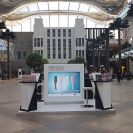H&M Group has been named number one out of 250 fashion brands in the latest Fashion Transparency Index, which ranks companies according to how much information they disclose about their suppliers, supply chain policies and practices, and social and environmental impact.
The fashion industry has been known for having a complex and opaque supply chain. Transparency has been a cornerstone of H&M Group’s sustainability work. Back in 2013, H&M Group was one of the first global fashion retailers to make its supplier list public.
Since then, the group has been taking steps to make it more accessible for customers to know where their products are made. Customers at arket.com can check the suppliers and factories making their favorite items, while last year, hm.com started offering additional information in almost all of their products, such as production country, supplier and factory names, and addresses, as well as the number of workers in the factory. In addition, customers can find out more about the materials used to make a specific garment and are reminded to recycle their garments.
“It is a great honor to be ranked as number one in the Fashion Transparency Index 2020 and a great recognition of our work. We always aim to be as transparent as possible in our progress towards a more sustainable fashion future, as well as the challenges ahead, in order to keep driving industry change. We are committed to continue taking steps for greater transparency so customers can make informed decisions and drive a positive impact in the industry through our extensive work to become fully circular and climate positive, while being a fair and equal company,”
Hanna Hallin, Global Strategy Lead for Transparency at H&M Group.
The Fashion Transparency Index, launched during the Fashion Revolution Week, creates awareness on important issues for the whole textile industry, such as transparency, good working conditions in the supply chain, and the need for shifting towards a circular economy. Taking responsibility for how H&M Group’s products are made is fundamental to the group. Good working conditions, the impact on climate and health and safety, are areas in which the company has been working for many years, developing higher standards for its production. Even in extraordinary situations, such as the rapid spread of the COVID-19 pandemic, the group stands by its responsible purchasing practices.
Due to the limited resources of the planet and the climate crisis, the way we produce and consume fashion must change. As a global fashion retailer, H&M Group has a big role to play, which is why the group is transforming its whole business to become fully circular and climate positive. Being circular means having a different approach to how fashion is designed, produced, and used, and how fashion should never be seen as waste. It should be treated as a valuable resource by reusing and recycling again and again.
Therefore, the company’s ambition to become circular includes, among others, offering its customers garment collecting options so a second life can be given through reusing and recycling, or increasing the use of recycled materials for its products, such as recycled polyester from old plastic bottles or recycled cotton from used garments.
For more information on H&M Group’s sustainability work, read here.








